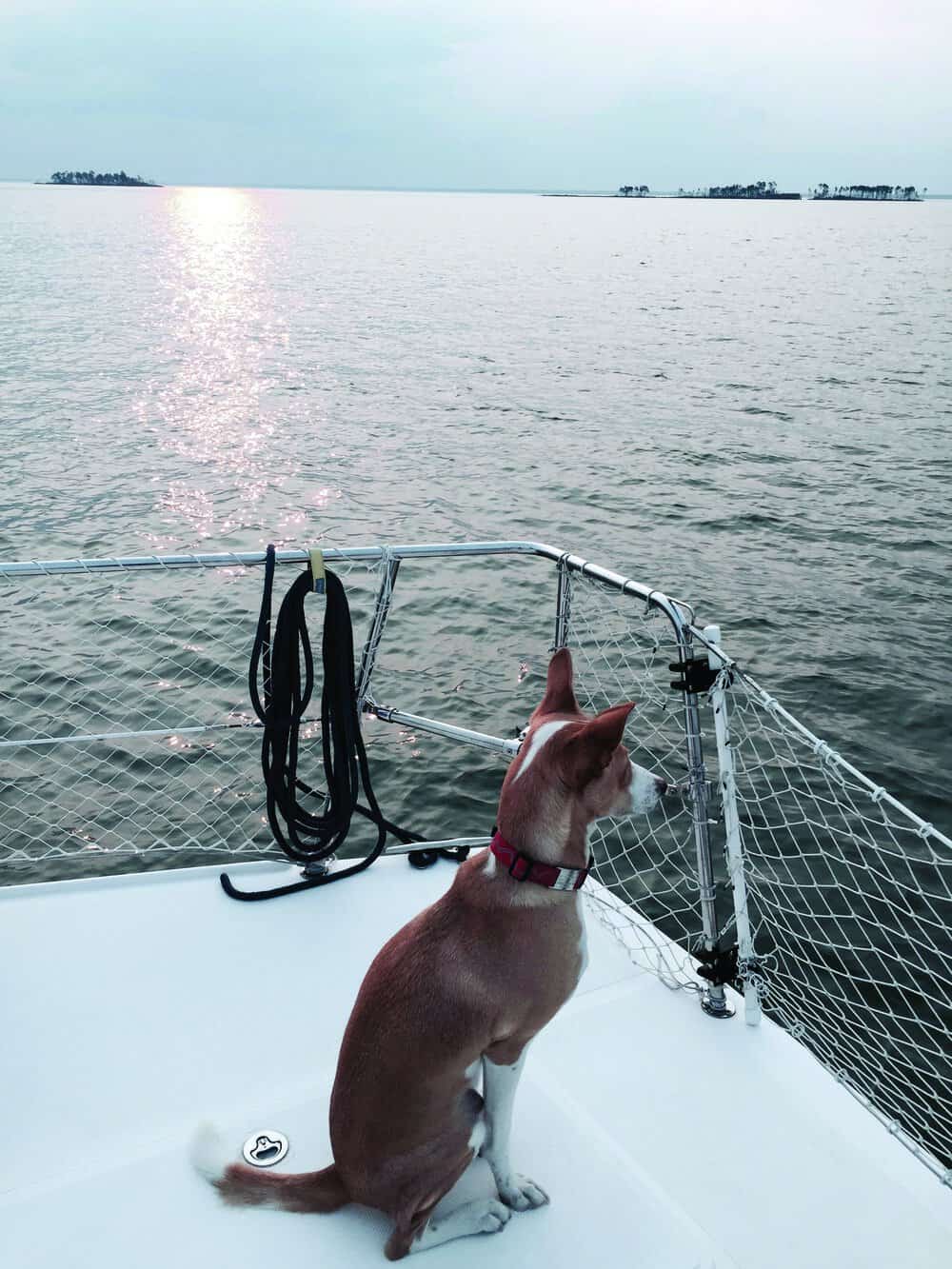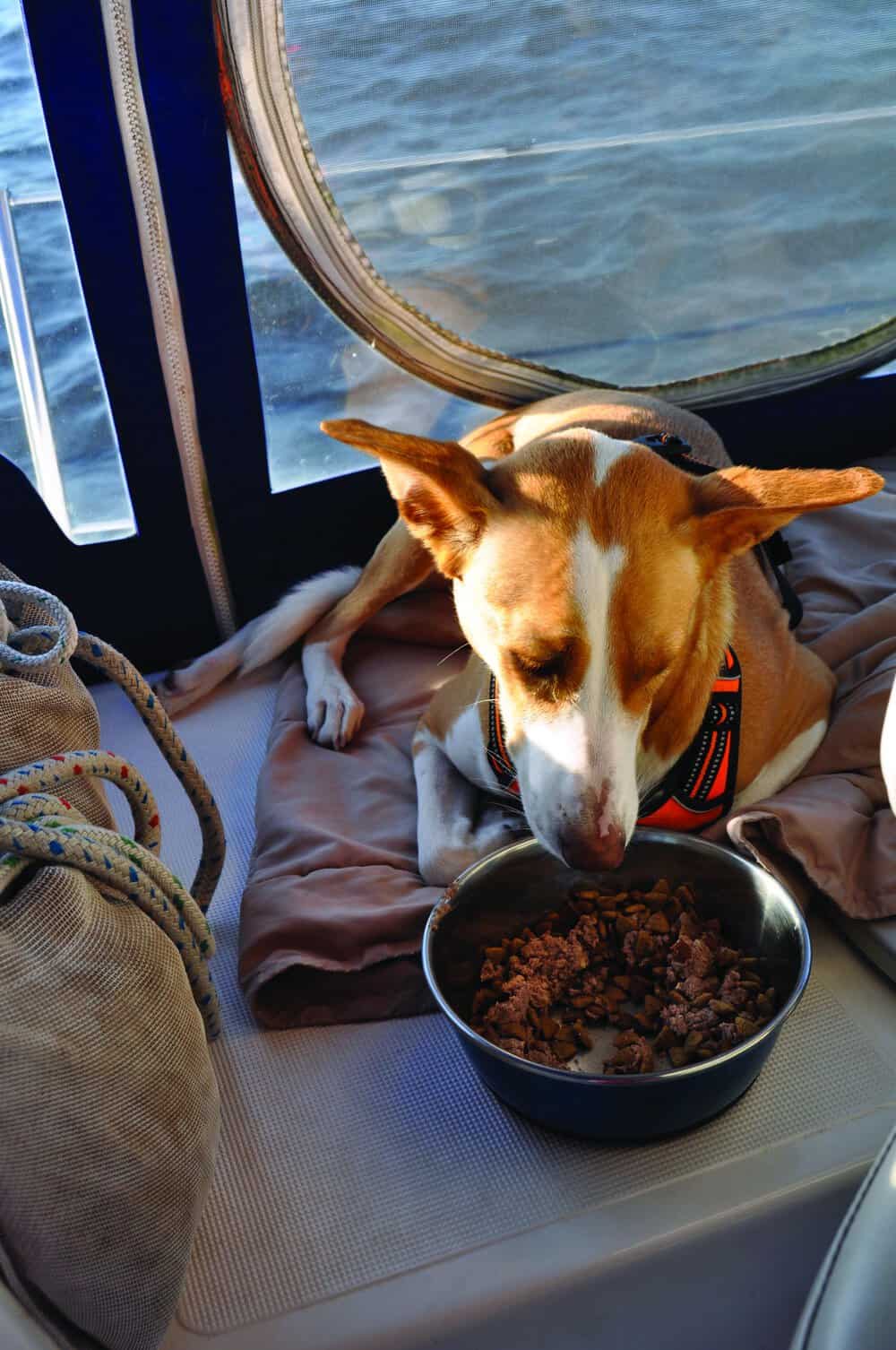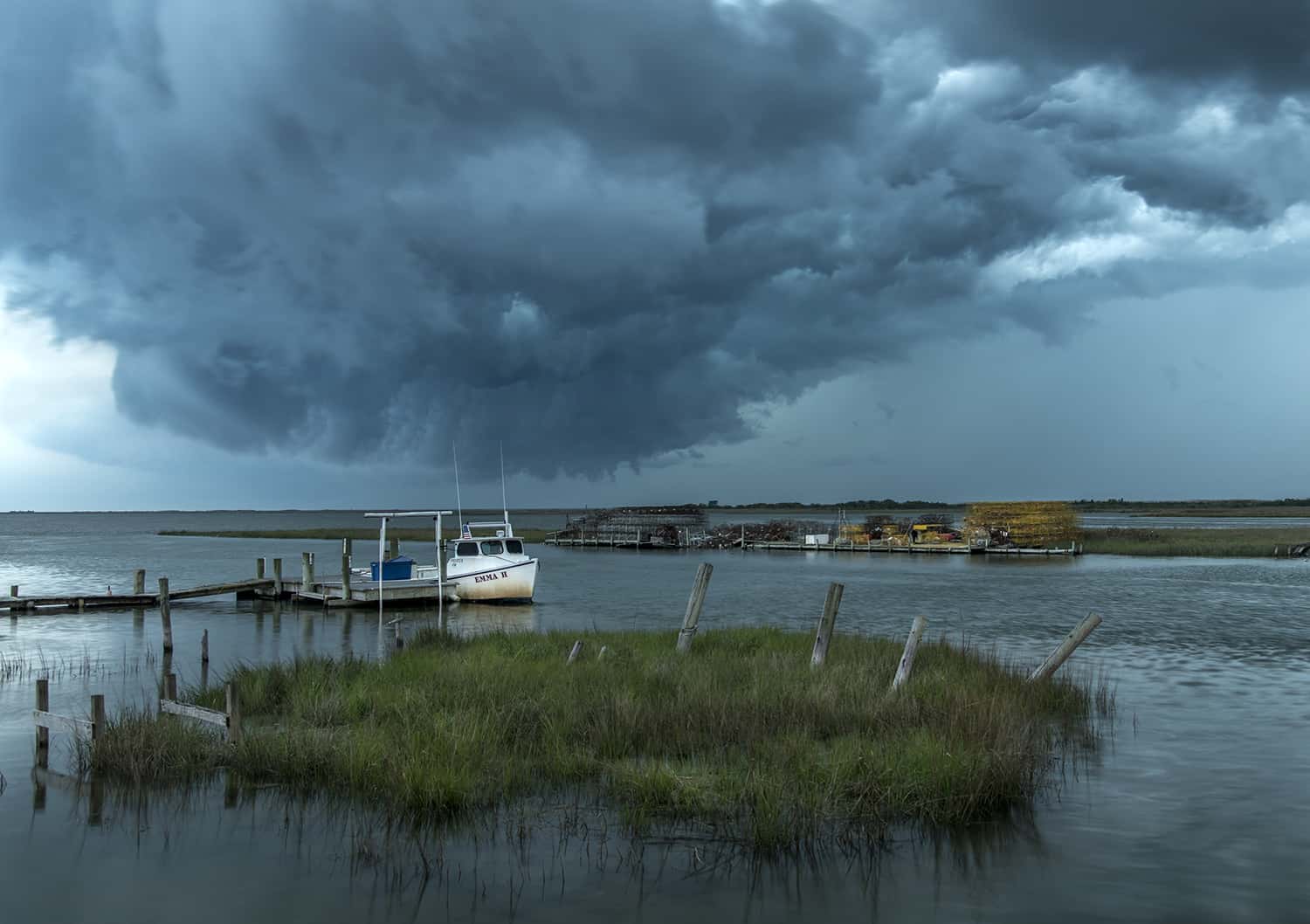By Jody Argo Schroath
We are five minutes out of the port of St. Petersburg, Fla., bumping up against a light chop coming across the long fetch of Tampa Bay, and Junior Seaman Sammy has what looks like a smile on his face. But I recognize that Mona Lisa look and know it’s not a sign of happiness. No, he’s thinking about giving back the breakfast kibbles that are suddenly sitting uneasily on his stomach. I can tell too that he’s thinking about how to keep his balance, because his four legs are splayed and bent. He’s hunkered down like a basketball player waiting for the tip off. In other words, he’s trying with all the might that his five-month life experience can muster to be ready for anything. He just has no idea what it’s going to be.
Meanwhile, Chief Security Officer Bindi, with a year and a half of maritime work under her belt, has assumed her customary perch beside the helmsman and is dozing unsympathetically as we get underway. Ho-hum, she’s thinking, at least I’m not in the car. Over the course of the day, she’ll keep to the shady side and lap up a bit of water from the cockpit water bowl. Otherwise, she’ll sleep or, when the sails are up, keep one wary eye out for signs of rebellion. You can’t trust a sail to stay where it belongs is her motto. She’s a born powerboater.
Which is all part of the great adventure that is cruising with pets. When you introduce a dog to cruising, you can never be sure what’s going to happen. Sammy, for example, has just completed his first month aboard and considers every inch of the boat his personal romper room. He runs circles around the deck like a hamster in a wheel. Down below, Sammy has his sleeping crate and a basket of toys to play with; on deck he has boats to watch and ducks to bark at. All day and night, his home rocks gently in her slip.
But then one morning, the lines come in, the engines hum, and without warning his home is slurping along through the water. And Sammy’s whole world changes. What’s his reaction going to be, I wonder. First, the Mona Lisa smile and the Kobe Bryant stance. Then a look around to see how everyone else is reacting to this alarming turn of events. Seeing that no one else seems the least bit ruffled, he searches for a safe place to settle. Thirty minutes later, he is sleeping soundly on the cockpit floor, his legs twitching as he dreams. The junior cadet is now a junior cruiser.
Sammy, like all other novice seamen, has a lot to learn about cruising on the Bay, whether he’s off on a day sail or a two-week cruise. So here are some of the things that he and others like him—and, of course, their owners—need to know.
The well-dressed
cruising dog
Every dog, like every human crewmember, needs to have a sturdy, well-designed lifejacket. You want one that fits well and won’t slip off, yet also doesn’t impede movement. It should also have good handles for lifting out of the water, guiding on and off the dock and snagging if the dog decides to jump ship. The lifejacket should have light-reflective strips or even an emergency water-activated beacon. Bindi wears an Aussie Natural, while Sammy sports a Paws Aboard model. Rough Wear also makes good
sturdy jackets.
When does your dog need to wear it? That depends on a number of factors and, in the end, your own good judgment. Slip it on when the weather is rough, if your pooch has a tendency to fall (or jump) off things, if you are going offshore or, on occasion, even down the middle of the Bay. On Moment of Zen, the dogs always wear lifejackets offshore and in rough weather. Lifejackets are also required when riding in the dinghy more than a very short trip in calm water. When it’s rough, I also add a tether to make sure they stay in the cockpit. I’ll also do that while docking because mine are always ill behaved and run around and bark. Perhaps yours are better.
For all those non-lifejacket occasions—like dozing in the cockpit and people-watching in the slip, Bindi and Sammy wear their harnesses. Bindi and Sammy’s current models are called Truelove and have reflective tape all over and small but sturdy handles on the back. There are a number of other good ones. Getting a good fit is the key.
I use European leashes as tethers because they have a lot of rings to allow for varying lengths.
Finally, they need identification tags on the harnesses and life jackets. I particularly like the ones from Boomerang (www.boomerangtags.com), which slip over the straps rather than dangle from the leash ring.
Doing the necessary
For short cruises, teaching the dog to “go” on deck or on an artificial grass pad or pee pad is probably not necessary, unless you plan to anchor out where there is no land access. There are a few anchorages on the Bay with nice sandy beaches in park land (like the Tar Bay access to Wye Island Natural Resources Management Area), but most of the Chesapeake is private property and owners are often not keen on having cruisers dinghy up with their dog—especially if they don’t clean up after him/her. There are some spots where cruisers have traditionally dinghied in to picnic or walk their pets. But no matter where you are, as a pet owner you are obligated to pick up pet stuff and hang onto it until you get to a receptacle. Be sure to carry plenty of biodegradable poop bags. We store the picked up poop in a separate little garbage can until we get home or into a marina. Many marinas now provide poop-bag dispensers and a separate collection can.
Marinas and dogs

I’ve never met a marina on the Chesapeake that didn’t welcome dogs. Really, so many people now cruise with their pets that it would be bad business for them not to put out the Fido mat. As I mentioned, many now provide poop bags. Some have designated walking areas, but if they don’t, avoid the picnic areas. Common sense applies.
Some marinas are better for dogs than others, either because of their docks or because of their location more than anything else. Floating docks are a dog-cruiser’s ideal. But most of the Bay’s marinas have fixed docks because there is little tide change; getting on and off is usually pretty easy.
On Moment of Zen, we carry an excellent and inexpensive aluminum dog ramp made by Solvit (www.solvitproducts.com) in the stern locker that can be telescoped to reach from the dock to the boat, if necessary. It’s sturdy enough to hold all dogs and most humans (I use it all the time), though it’s not made for people. It has been a terrific addition to our inventory.
Pets in the city
We particularly love to stop at marinas in towns, because I’ll have plenty to see, and we all like walking along village or city sidewalks. Places like St. Michaels, Oxford, Cambridge, Cape Charles, Onancock and Crisfield on the Eastern Shore are great. There are plenty more. As a bonus, dogs are allowed on the Cape Charles beach early in the morning and just before dark. On the Western Shore, we particularly enjoy Yorktown, Norfolk, Hampton, Havre de Grace, Washington D.C., Alexandria, Annapolis and Solomons.
Happily, the Chesapeake is rich in dog-friendly destinations. Some shops and many restaurants with outdoor seating now welcome pets. And if you want to go out to dinner, it’s easy to leave dogs in the cabin. Just make sure the cabin is cool and well ventilated or, if you are in a marina and it’s hot, that the air-conditioner is on and there is plenty of water. On Zen, junior cadet Sammy stays in his wire crate, which is tucked under the saloon table, because he still has a few bad habits, but Bindi has the run of the cabin.
Pets in the country
But what if you want to anchor out as far from cities and towns as you can get? Here’s what I do if there are no good landing spots: I pull up the charts or check the Maryland or Virginia websites and look for nearby boat ramps—I nearly always find at least a couple. Then I choose the one that looks as if it has a reasonable place to anchor within easy dinghy distance. Boat ramps are often in well-protected areas, so this very often does the trick. Wherever you have a boat ramp, you have a built-in dinghy landing by just grounding on the ramp, then pulling the boat out of the way.
But what if there’s no boat ramp around? Then I look for a park of any variety, whether it has a dock or not. It is usually possible to land a dinghy along the shoreline of a park, even if you have to scramble up the bank a bit.
No park? Some country towns have dinghy docks (tiny Claiborne, Md., has a good-size one). Others may have temporary-use docks or old wharves. All these work just fine.
Then there are waterfront restaurants, which often have docks for customers. There is usually space to tie up a dinghy out of the way of general traffic. And then you can treat yourself and the dog to a crabcake sandwich.
But sometimes there is no solution and we just settle down in the cockpit with a chew toy and a cold beer. This is when you will be happy if you’ve taught the dog to use the onboard piddle pad or pile of old rope. There are a hundred techniques, a few of which occasionally work. (I could write a treatise.)
Keeping healthy

All dogs should be on heartworm pills and some kind of flea and tick preventive, anyway, so that will take care of most common issues. Deer ticks are a particular menace (Lyme disease is rampant), and sometimes very small indeed and nearly impossible to see. As a precaution, be sure to check the dog (and yourself) for the little devils, particularly after a stroll through an
open field or deciduous woods.
For emergencies, I keep a Pet First Aid app on my phone, and a veterinarian is nearly always a few phone calls away.
Dogs can get sunburned, so pack some baby sunscreen lotion, unless you have a Norwegian elkhound, which has two coats—in which case you’d better pack some extra vacuum-cleaner bags instead.
On Moment of Zen, we have a swell shower gizmo on the swim platform that rinses away most of the mud and salt, and plenty of dog towels in a plastic bin in the cockpit locker for drying them off. If you are in a marina, just hook up the hose to get the job done.
Dogs on boats: a
nuisance or a necessity?
Yes, it’s sometimes a pain in the neck to cruise with your dog. There will be lots of extra dirt down below, an endlessly renewable supply of dog fur everywhere and decks that are never quite free of paw prints. And then there is the obligation to take them ashore for some exercise from time to time, even if they take care of things on the boat.
I know I’m not going to convince anyone who isn’t already inclined to take the dog along, but for me—and many many boaters—the companionship, shared adventure and opportunity for unanticipated amusement is well worth every paw print. I have explored many parts of the Chesapeake, both rural and urban, only because I felt the dogs needed exercise more than I needed that first cold beer or glass of wine. I admit it, I get slothful at the end of a day’s cruise, but when I lower the dinghy and go ashore, I generally get at least as much out of it as the dog.
Thanks to them, I have walked miles of neighborhoods in towns across the Bay. I have clamored over fallen trees on beaches along the Potomac, the Wye and the James rivers. I have happened upon street concerts in Yorktown and watched eagles rob an osprey over the Little Wicomico River. Because dogs are great conversation starters, I have met legions of people related and unrelated to boating. I have read a lot of historical markers waiting for them to sniff the bushes.
It is day four of our trek north, and we are sitting at the dock in Fort Pierce when Sammy decides to try out his dog paddle. We hear a plop and tear forward to find him swimming hard toward a tiny mangrove island covered in brown pelicans. I shout and whoop at him and he finally turns around and swims toward the boat. He is enjoying himself immensely. Finally, he swims over to the swim platform. I grab his harness and haul him aboard. A few minutes and a thorough wash-down later, he is back at the rail, eying the pelicans and sizing up the jump.
Tomorrow we will be jumping offshore at Fort Pierce Inlet and heading north. You may be sure that Sammy will be tethered to the cockpit table and wearing his lifejacket. The little swabby is now a full-on pirate.
–Jody Argo Schroath



